Introduction
For startups, biotech innovators, deep tech companies, and university spinouts, research and development (R&D) drives breakthrough innovation—but without a proactive intellectual property (IP) strategy, those discoveries risk being unprotected, undervalued, or easily replicated. Many innovators delay IP planning until late in the development cycle, often compromising their competitive edge. In today’s fast-moving market, integrating IP into early R&D is no longer optional—it’s essential. Strategic patent planning, including offensive and defensive filing approaches, jurisdictional targeting, and provisional-first strategies, helps maximize ROI and attract investors.
Early IP investment enhances valuation, funding potential, and exit opportunities. Tools like patent landscape analysis and competitive patent monitoring offer deep insights into white space, emerging technologies, and potential threats—allowing teams to refine R&D direction and outmaneuver competitors. By embedding IP thinking into their innovation process, companies can secure long-term value, navigate global markets with confidence, and build defensible IP portfolios that scale.
Why Integrate IP Strategy with R&D?
A well-aligned IP strategy amplifies the impact of R&D by:
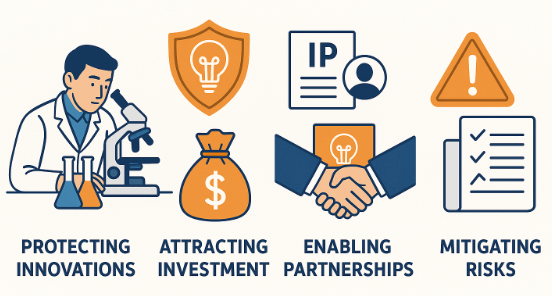
- Protecting Innovations: Patents safeguard novel inventions, preventing competitors from replicating or exploiting them.
- Attracting Investment: A robust IP portfolio signals commercial potential to investors, particularly in capital-intensive fields like biotech and deep tech.
- Enabling Partnerships: Strong patents facilitate licensing deals, collaborations, and joint ventures, creating revenue streams.
- Mitigating Risks: Early IP planning helps avoid infringement, freedom-to-operate issues, and costly legal disputes.
Without integration, companies risk missed filing deadlines, weak patent claims, or unprotected trade secrets, all of which can erode competitive advantage. By embedding IP strategy into R&D from the outset, companies can align their innovation and commercialization goals seamlessly.
Step 1: Align IP Goals with Business Objectives
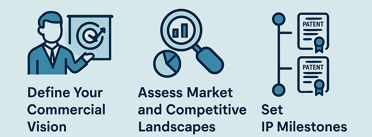
Define Your Commercial Vision
Before filing a single patent, R&D-driven companies must clarify their business objectives. Are you developing a product for market launch, licensing a technology, or building a platform for future innovations? For example:
- A biotech startup developing a gene-editing therapeutic might prioritize patents on specific molecules or delivery systems to attract pharmaceutical partners.
- A deep tech company building AI-driven diagnostics may focus on protecting novel algorithms or hardware integrations to secure venture capital.
- A university spinout might patent enabling technologies to license across multiple industries, such as synthetic biology tools for biomanufacturing.
Assess Market and Competitive Landscapes
Conduct a competitive analysis to identify gaps and opportunities.
Use patent data to analyze competitors’ patents. This informs whether to pursue broad foundational patents, narrow improvement patents, or defensive filings to block competitors.
Set IP Milestones
Integrate IP milestones into your R&D timeline:
- Early Stage: File provisional patents to secure priority dates during proof-of-concept.
- Development Stage Refine claims and file non-provisional patents as prototypes mature.
- Pre-Commercial Stage: Expand filings to cover variations, applications, or international markets.
- Patentable Subject Matter: Inventions must be novel, non-obvious, and fall within patent-eligible categories such as processes, machines, devices, or compositions.
- Novelty & Prior Art: Any public disclosure—whether in journals, blogs, or conference talks—can impact patentability. Teams must understand what qualifies as prior art and how it affects filing strategies.
- Documentation Practices: Encourage consistent use of lab notebooks, research logs, and invention disclosure forms (IDFs) to establish inventorship and support future patent filings.
- A new prototype or experimental result is achieved
- A novel use of existing technology is discovered
- A unique technical process or tool is developed
- AI & Deep Tech: Focus claims on tangible technical improvements (e.g., faster neural networks for imaging), tie software to hardware or real-world systems, and align with USPTO's eligibility guidance.
- Biotech & Genomics: Avoid naturally occurring sequences; instead, claim synthetic constructs (like cDNA), engineered proteins, or novel gene-editing methods (e.g., CRISPR), especially those with transformative diagnostic or therapeutic utility.
- Synthetic Biology: Highlight engineered organisms or pathways with clear human intervention, such as designed genetic circuits or enhanced metabolic functions, while steering clear of claims covering unmodified natural entities.
- Avoid duplication of existing solutions
- Focus efforts on truly novel and inventive ideas
- Save valuable time and resources by redirecting research early if overlapping inventions are found
- Identify potential infringement risks in specific countries
- Recommend design modifications or alternative approaches
- Enable informed go-to-market decisions with legal confidence
- Help researchers make smart pivots when barriers are identified
- Suggest licensing or cross-licensing opportunities for blocked features
- Integrate IP considerations into the product development lifecycle
- Track the patenting activity of key players in your domain
- Understand competitors' R&D focus areas and technology strengths
- Benchmark your innovation pipeline against theirs
- Developing truly novel products or technologies
- Reducing the likelihood of future IP disputes
- Creating a competitive edge in untapped domains
- Detect potential IP barriers to your R&D projects
- Modify designs early to avoid costly legal entanglements
- Navigate around active patents through licensing, design-around, or acquisition
- Technology Trend Mapping
- Patent Filing Trends by Geography
- Top Assignees and Inventors
- Patent Inception and Growth Timeline
- Legal Status and Expiry Monitoring
- Problem: What technical challenge or inefficiency was being faced before this invention?
- Solution: What unique method, structure, or system does the patent claim to overcome the problem?
- Application: Where or how can this solution be applied in the real world (e.g., product, process, platform)?
- Quickly understand why a patent exists.
- Relate the innovation to their technical and product challenges.
- Make better decisions about filing, licensing, or design workarounds.
- Product: Represented as a whole or broken into functional components.
- Patents: Labeled as per features (e.g., touch sensor, AI control module, new battery enclosure).
- Mapping Lines: Arrows or connections visually indicate which patent applies to which part.
- Helps engineers and product managers see how IP protects innovation.
- Assists legal teams in enforcing or licensing relevant patents.
- Supports freedom-to-operate (FTO) and infringement analyses.
- Foundational Patents: Broad claims covering core technologies.
- Improvement Patents: Narrower claims protecting specific enhancements.
- Defensive Patents: Filings to block competitors in key markets.
- Trade Secrets: Protect proprietary processes or data not suitable for patenting.
- Copyrights: Secure software code or user interfaces in AI-driven products.
- Trademarks: Build brand identity for commercialized technologies.
- Regulatory Exclusivities: Leverage FDA or EMA exclusivities for biologics or orphan drugs.
- Use provisional patents to defer costs.
- Prioritize filings in high-value markets.
- Conduct prior art searches.
- Draft claims that withstand eligibility scrutiny.
- Navigate international filings and office actions.
- A startup developing a CRISPR-based therapeutic filed a provisional patent early, securing a priority date. By refining claims to cover a novel delivery vector, they avoided Myriad-related rejections, attracting a $50M licensing deal.
- A university spinout faced Alice rejections for an AI diagnostic tool but secured a patent by emphasizing integration with a medical imaging device, enabling a healthcare partnership.
- A small enterprise patented a synthetic microbe for biofuel production, using PCT filings to protect key markets, leading to a big funding opportunity.
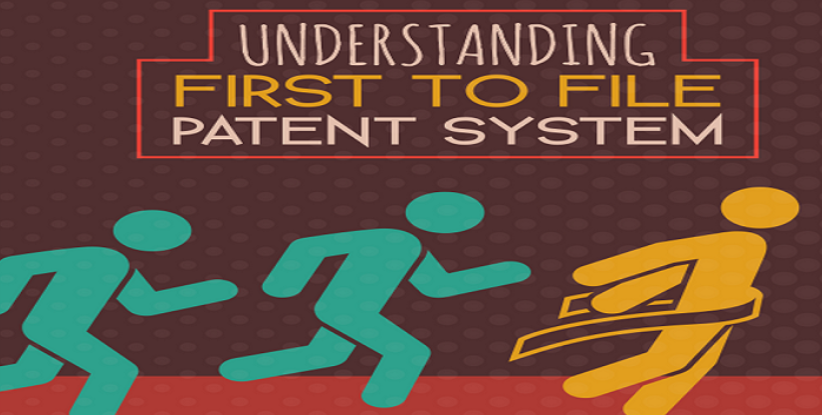
Step 2: Embed IP Awareness in R&D Processes
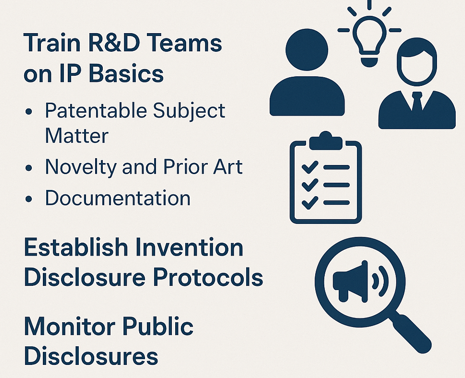
Train R&D Teams on IP Basics
Most scientists and engineers aren't formally trained in intellectual property, which can lead to missed opportunities or unintended public disclosures. Equipping R&D teams with essential IP knowledge early on ensures that innovations are protected, valued, and strategically aligned with business goals.
Key IP Concepts Every Researcher Should Know:
Establish Invention Disclosure Protocols
Implement a structured invention disclosure protocol to capture and evaluate innovations at key R&D checkpoints. Require submission of IDFs when:
Each IDF should include clear technical descriptions, potential applications, and comparisons to known solutions. Regular reviews by an IP committee or external counsel will help prioritize high-value inventions for patent protection.
Monitor Public Disclosures
Public disclosures—including preprints, presentations, or website content—can trigger loss of rights, especially in countries with absolute novelty requirements (e.g., Europe). In the U.S., such disclosures start a strict one-year grace period. Always coordinate with the IP team before any external communication, ensuring provisional applications are filed in advance where necessary.
Step 3: Navigate Patent Eligibility Challenges

Understanding Legal Hurdles
Fields like AI, biotech, and synthetic biology face heightened patent eligibility challenges due to key U.S. Supreme Court rulings (Alice v. CLS Bank, Myriad Genetics, Mayo v. Prometheus). These decisions limit patentability for abstract ideas, natural phenomena, and laws of nature—impacting innovations involving algorithms, isolated DNA, or diagnostic methods.
Strategies for AI, Biotech, and Synthetic Biology
Drafting for Eligibility and Impact
Patent applications in these domains must be carefully crafted to emphasize practical application, technical specificity, and inventive human input. Collaborating early with IP professionals helps structure claims that not only withstand eligibility scrutiny but also deliver strong commercial and legal protection.
Step 4: Conduct prior art and FTO searches before development begins
Ensure Novelty with Prior Art & Patentability Searches
Before development begins, IP experts conduct global prior art searches to determine whether similar inventions already exist. This helps R&D teams:
This strategic input leads to stronger patent filings and better-aligned innovations.
Guide Freedom to Operate (FTO) for Market Readiness
Before launching a product, IP professionals assess whether it may infringe on any existing/enforceable patents in the target market. FTO searches help:
This ensures the invention can be commercialized without legal roadblocks.
Enable Strategic R&D Decisions
With constant collaboration, IP teams:
This allows R&D teams to innovate with clarity, speed, and legal assurance.
Step 5: Leveraging Patent Landscape Analysis for R&D Strategy
Patent landscape analysis is a strategic tool that empowers R&D-focused organizations to make informed, data-driven innovation decisions. By systematically analyzing global patent filings, R&D teams gain clarity on where to innovate, what to avoid, and how to outpace competitors.
Competitor Insights:
Gain visibility into who is innovating, what technologies they're protecting, and how aggressively they file.
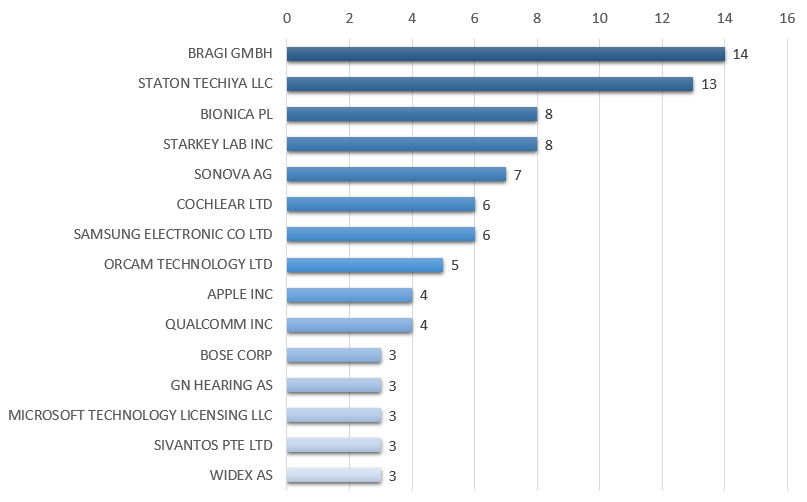
Innovation Opportunities:
Spot areas with low or no patent activity—these "white spaces" represent opportunities for:

Mitigate Infringement Risk
By reviewing existing patents across geographies, you can:
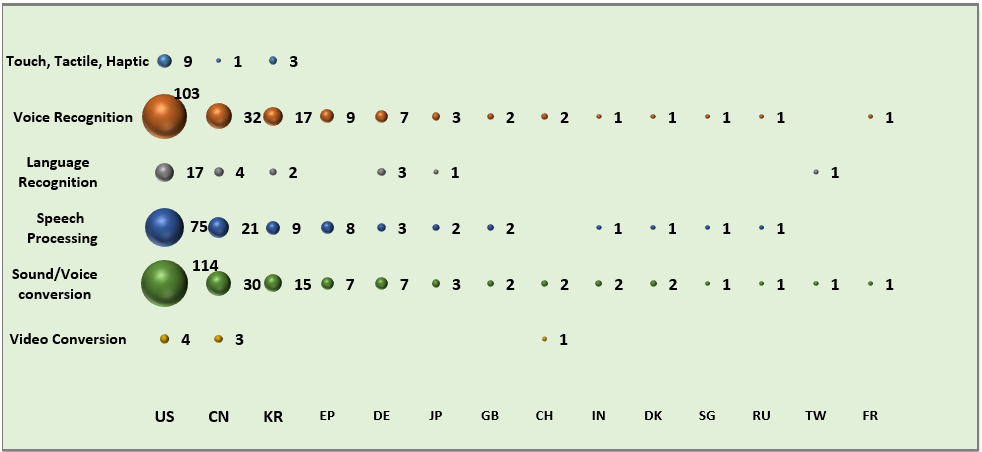
Additional Strategic Insights from Landscape Analysis
A well-executed patent landscape analysis enables R&D teams to innovate confidently, allocate resources efficiently, and maximize the commercial value of their inventions—while staying ahead of legal and market barriers.
Step 6: Make IP Understandable to R&D
Patent documents can be dense, legalistic, and intimidating. To encourage active R&D engagement with IP strategy, companies should simplify and contextualize IP data.
Two powerful techniques:
Problem–Solution–Application (PSA): Break patents down into digestible segments to clarify what problem was solved and how.
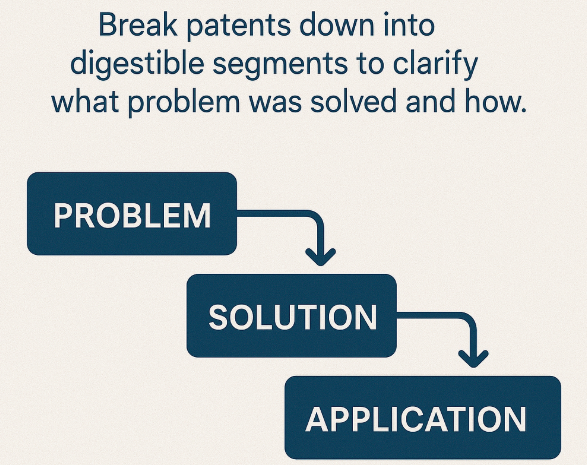
What It Means:
This method breaks down a patent into three clear and practical parts:
Why It Matters:
This approach helps R&D, legal, and business teams:
Product-to-Patent Mapping: Visually link patents to specific products or features, making the strategic value of IP clear to engineers.
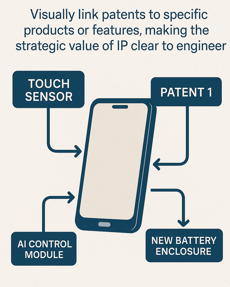
What It Means:
This is a visual tool that directly links a company’s product (or even a component) to the patents that protect its features or functionality.
Patent Mapping Overview:
Why It Matters:
These tools bridge the language gap between legal and technical teams.
Step 7: Build a Scalable IP Portfolio
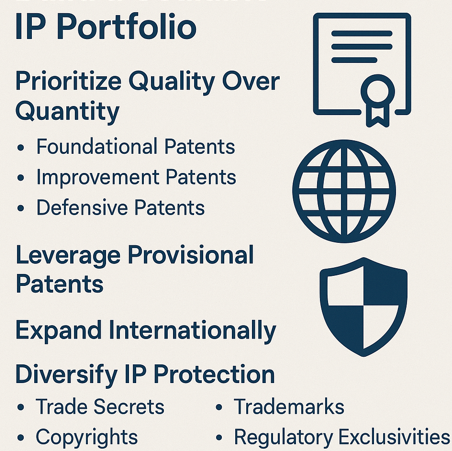
Prioritize Quality Over Quantity
A lean, high-quality patent portfolio is more valuable than numerous weak patents. Focus on:
Leverage Provisional Patents
Provisional patents are cost-effective tools to secure early priority dates. They allow 12 months to refine claims, gather data, and assess commercial viability before filing a non-provisional application.
Expand Internationally
Global markets are critical for R&D-driven companies. Use the Patent Cooperation Treaty (PCT) to file international applications, preserving rights in multiple jurisdictions. Prioritize key markets (e.g., U.S., EU, China) based on commercial goals and patentability standards.
Diversify IP Protection
Consider:
Step 8: IP Monetization is the end of IP lifecycle
In today's innovation-driven economy, Intellectual Property (IP) is no longer just a legal formality—it's a core business asset. As such, the collaboration between R&D and IP teams is crucial to maximizing the value of innovation. IP monetization is not an isolated process; it represents the culmination of a carefully managed IP lifecycle that begins at the ideation stage and continues through strategic deployment. To fully capitalize on IP, R&D and IP professionals must work hand-in-hand throughout the following stages:
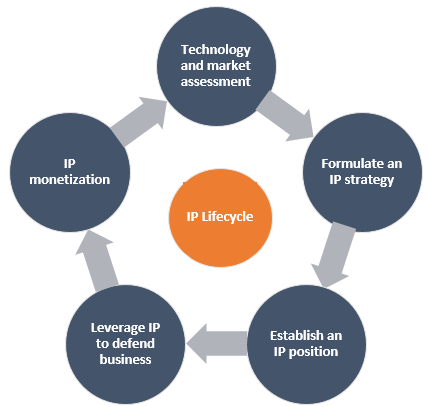
Technology and market assessment:
Early collaboration allows IP experts to guide R&D efforts toward technologies with strong market potential and defensible IP positions. This joint assessment ensures that innovations are not only novel but also aligned with market demand, increasing the likelihood of commercial success.
Formulate an IP strategy:
An effective IP strategy must be integrated into the R&D process from the outset. By involving IP professionals early, companies can build portfolios that are strategically aligned with business goals, competitive landscapes, and future revenue opportunities.
Establish an IP position:
Creating a strong IP position requires careful documentation, filing, and management of patents, trademarks, and trade secrets. R&D teams provide the technical insights, while IP teams ensure legal robustness—together, they lay the foundation for a defensible and valuable IP portfolio.
Leverage IP to defend business:
A well-established IP position enables companies to protect their innovations from infringement, maintain competitive advantage, and negotiate from a position of strength. Collaboration ensures that R&D is aware of existing IP landscapes, avoiding costly conflicts and identifying potential licensing opportunities.
IP monetization:
Ultimately, the goal of the IP lifecycle is monetization—through licensing, sale, strategic partnerships, or increased company valuation. Monetization is most effective when IP is developed with clear market insight and strategic foresight, which is only possible through seamless collaboration between R&D and IP teams.
Step 9: Manage Costs and Resources
Budget Strategically
Patent filings are expensive, with costs ranging from $10,000 to $50,000 per patent. For startups:
Collaborate with IP Professionals
Engage patent attorneys with expertise in your field to:
Monitor and Enforce
Regularly audit your IP portfolio and use patent monitoring tools to track competitors and identify infringement. Enforce patents strategically through licensing or litigation, balancing costs against returns.